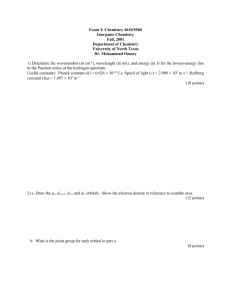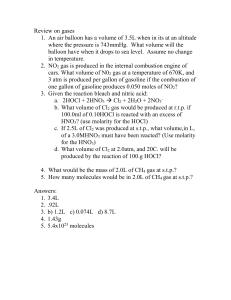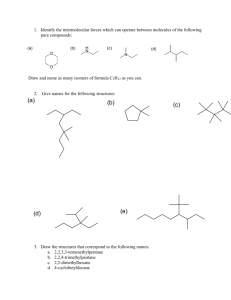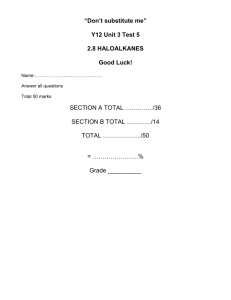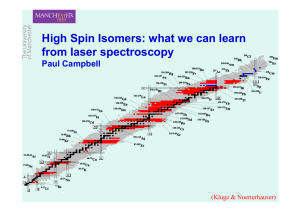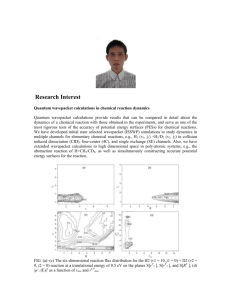C:\CSC-DIC\LakeheadU 6.wpd
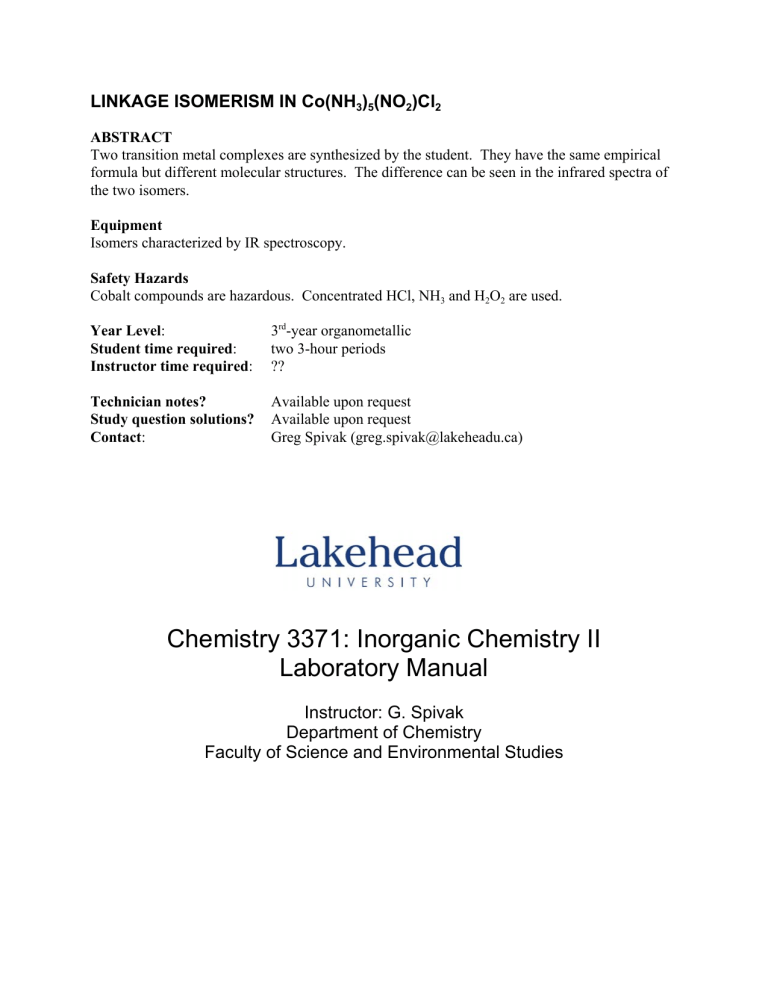
LINKAGE ISOMERISM IN Co(NH
3
)
5
(NO
2
)Cl
2
ABSTRACT
Two transition metal complexes are synthesized by the student. They have the same empirical formula but different molecular structures. The difference can be seen in the infrared spectra of the two isomers.
Equipment
Isomers characterized by IR spectroscopy.
Safety Hazards
Cobalt compounds are hazardous. Concentrated HCl, NH
3
and H
2
O
2
are used.
Year Level :
Student time required :
3 rd -year organometallic two 3-hour periods
Instructor time required : ??
Technician notes?
Available upon request
Study question solutions?
Available upon request
Contact : Greg Spivak (greg.spivak@lakeheadu.ca)
Chemistry 3371: Inorganic Chemistry II
Laboratory Manual
Instructor: G. Spivak
Department of Chemistry
Faculty of Science and Environmental Studies
Chemistry 3371 Experiment One
Experiment 1:
Linkage Isomerism in Co(NH
3
)
5
(NO
2
)Cl
2
Purpose of the Experiment
In this experiment, the student is given the opportunity to prepare and observe (via IR spectroscopy) the various linkage isomers possible for a number of Co(III)/NO
2
complexes.
Introduction
Transition metal complexes that have the same chemical formula but are different structurally are called isomers . It is because of the nature of the ligands and the variety of geometries that are available to transition metal complexes that many different types of isomerism occur in coordination and organometallic chemistry. For example, certain ligands contain more than one donor atom which may form a bond with a metal. These ambidentate ligands lend themselves to a form of isomerism called linkage isomerism . Thus, while linkage isomers may have the same chemical formula, they do not have the same structural arrangement of ligands. In this experiment, the student will examine the ambidentate nature of the NO
2 of NO
2
ligand in a series of cobalt complexes. The mode of coordination
can be easily elucidated using IR spectroscopy.
Experimental Procedure
Special Notes and Safety Precautions
The following procedures require the use of concentrated aqueous solutions of ammonia and HCl, and should therefore be conducted in the fumehood. Care must also be taken when handling the hydrogen peroxide solution. In any case of contact, flush the exposed area with copious amounts of water. Finally, before the various isomers of Co(NH
3
)
5
(NO
2
)Cl
2
can be prepared, the precursor complex [Co(NH
3
)
5
Cl]Cl
2
must be synthesized. Note that both isomer A and B must be prepared and analysed together on the same day, so use time wisely .
The required laboratory time for this experiment is 2 periods .
Synthesis of Pentaamminechlorocobalt(III) chloride, [Co(NH
3
)
5
Cl]Cl
2
.
This synthesis requires about 2 hours and must be completed in one laboratory period.
In a 250 mL Erlenmeyer flask containing a stir-bar, dissolve NH
4
Cl (5.0 g) in concentrated ammonia solution (30 mL). While the solution is stirring, slowly add (in several smaller portions)
CoCl
2
C
6H
2
O (about 10 g, accurately weighed ); a pale brown slurry should be obtained. With continued stirring, add dropwise (over approximately 5 minutes) 30% H
2
O
2
(8 mL); the mixture
Chemistry 3371 Experiment One will foam rapidly if the H
2
O
2
is added too quickly . Stir the deep, dark purple mixture for about
10-15 minutes (or until foaming ceases), and then slowly add concentrated HCl (30 mL); a redpurple slurry will form. Heat the mixture on a hot-plate (to about 85°C), while stirring, for approximately 20 minutes. The mixture is then cooled to room temperature and the royal purple precipitate of [Co(NH
3
)
5
Cl]Cl
2
is filtered off (Büchner). Finally, wash the product with several small portions of ice water (3 × 5 mL). The product should be air-dried over a week in your locker. Record the yield of the final product after drying and calculate the yield based on the amount of cobalt chloride hydrate used.
Synthesis of Co(NH
3
)
5
(NO
2
)Cl
2
: Isomer A.
Both isomer A and isomer B must be prepared in the same laboratory period.
In a 250 mL Erlenmeyer flask containing a stir-bar, dilute concentrated ammonia solution (8 mL) with water (80 mL), and heat on a hot-plate, while stirring, to approximately 60-70°C. To the heated, stirring solution, add [Co(NH
3
)
5
Cl]Cl
2
(about 5 g, accurately weighed ), as prepared above. Heat the mixture for approximately 20-30 minutes until the reagent dissolves to give a clear, deep dark purple solution. Cool the solution in ice to about 10°C, and add dilute (2 M) HCl (approximately 50 mL) slowly to the cooled solution, with stirring, until it is just neutral to litmus (red paper no longer turns blue). While still in the ice bath, add sodium nitrite (5.0 g) in several small portions, followed by dilute (5 mL of 6 M) HCl. Leave the mixture in the ice bath for approximately 30 minutes (in order to complete the precipitation), and then filter off (Büchner) the pinkish-red product. Wash the product with ice water (25 mL), followed by ethanol (25 mL), and allow the product to dry by leaving it in the funnel with the water aspirator on (break the solid up into a powder using a spatula).
Record the yield of the final product after drying (calculate a yield based on the amount of
[Co(NH
3
)
5
Cl]Cl
2
used) and record the IR spectrum (Nujol). Note: this isomer is not particularly stable and it is imperative that the IR spectrum be acquired soon after synthesis (i.e., during the same laboratory period in which it is prepared).
Place a small sample (no more than about
0.5 g) of isomer A in an oven (set no higher than 100°C) and heat for 24 hours. Note the colour of the ‘new’ product after heating, and record the IR spectrum (Nujol). Use the rest of isomer A for the preparation of isomer B, below.
Synthesis of Co(NH
3
)
5
(NO
2
)Cl
2
: Isomer B.
In a beaker, bring a volume of water (20 mL) to a boil and then add a few drops of concentrated ammonia solution. To the boiling solution, add a sample of isomer A (about 2 g, weighed accurately ). Remove the beaker from the hot plate and, as the solution cools, add concentrated HCl
(20 mL). Allow the mixture to cool thoroughly, filter (Büchner) the product, and wash it with ethanol (15 mL). Allow the yellow-orange product (which is isomer B) to dry (leave it in the funnel with the aspirator on), record the yield, and obtain the IR spectrum (Nujol). Calculate the yield based on the amount of Isomer A used.
Chemistry 3371
Final Report
Experiment One
The report should include all measurements ( e.g., weighings, etc.) and calculated yields, colours of the products, and the three IR spectra. You need only concentrate on the IR absorptions pertaining to the NO
2
ligand when assigning the peaks in your IR spectra.
Refer to Infrared and
Raman Spectra of Inorganic and Coordination Compounds by Kazuo Nakamoto in the Lakehead
University library for assistance. The following literature reference will also assist in interpreting the IR spectra: Journal of the American Chemical Society 1956 , volume 78, p. 887. Include discussions on the following:
(1) Describe the role (using equations) of the hydrogen peroxide in the synthesis of
[Co(NH
3
)
5
Cl]Cl
2
(remember, this is done in alkaline solution!)
(2) Explain (using Lewis structures) how NO
2
can serve as an ambidentate ligand. Be sure to
(i) identify how NO
2
can attach to a metal, and (ii) clearly indicate the geometry of the ligand when attached.
(3) Using the IR spectra of the products, identify the mode of coordination of the NO
2
ligand in isomer A and isomer B. What happens to isomer A when it is heated? (Note: isomer A and
B actually exist in equilibrium).
3
)
5
(NO
2
)Cl
2
and identify all forms of isomerism.
References
1.
Penland, et al.
, J. Am. Chem. Soc.
, 1956 , 78 , 887
2.
K. Nakamoto, Infrared and Raman Spectra of Inorganic and Coordination Compounds,
New York: Wiley-Interscience (ISBN: 0471194069,), 1997
